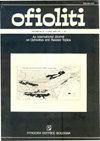Petrology and geochemistry of sheeted dykes and pillow lavas from the Sabzevar Ophiolitic Mélange (Northeast Iran): new Constraints for the Late Cretaceous evolution of the Neo-Tethys Oceanic Basin between the Central Iranian Microcontinent and Eurasia
IF 1.3
4区 地球科学
Q2 GEOLOGY
引用次数: 5
Abstract
TheSabzevarophiolite-bearingmelangemainlyincludestectonic slicesofophiolitesregardedas remnants of the Late Cretaceous oceanic basin located between the northern margin of the Central Iran Microcontinent and the southern margin of the Turan (Eurasia) plate, as well as remnants of its northern continental margin. We present here new mineral chemistry and whole rock chemical data on the sheeted dyke complex and pillow lavas series from this ophiolite. The sheeted dykes consist of basalts and basaltic andesites showing island arc tholeiitic (IAT) affinity (Group 1). They display low TiO 2 (0.37-0.81 wt%) contents and N-MORB normalized incompatible element patterns featuring Th enrichment and Ta and Nb depletion. The pillow lavas show different chemical features compared to the sheeted dykes and can be subdivided in two distinct geochemical groups. The first Group of pillow lavas (Group 2) mainly consists of andesites showing a clear calc-alkaline (CA) affinity with low TiO 2 (0.71-0.81 wt%) contents. Their N-MORB normalized incompatible element patterns display marked enrichments in Th, U, La, and Ce, and depletion in Ta, Nb, and Ti. The second Group of pillow lavas (Group 3) is mainly represented by alkaline basalts with high TiO 2 (1.54-3.45 wt%) contents. N-MORB normalized incompatible element patterns show significant Th, Ta, and Nb enrichments. Trace element modeling shows that CA primary melts were generated by 20% partial melting of a depleted lherzolite mantle source that had been enriched by continental crust chemical components. IAT basalts were generated from various degrees of partial melting of either depleted lherzolitic or harzburgitic mantle sources bearing no or negligible influence from continental crust components. Alkaline basalts were generated by polybaric partial melting of an enriched within-plate oceanic mantle source. A new tectono-magmatic model that can explain the different rock association cropping out in the Sabzevar ophiolite is proposed. This model implies the existence, on the southern margin of the Turan plate during the Late Cretaceous, of a continental arc-forearc system where CA and IAT rocks were erupted, respectively. Alkaline basalts were erupted in a subduction-unrelated oceanic basin and then tectonically accreted to the forearc as a consequence of the collision between the seamount and the arc-forearc system.Sabzevar蛇绿岩(伊朗东北部)片状岩脉和枕状熔岩的岩石学和地球化学:伊朗中部微大陆和欧亚大陆之间新特提斯海洋盆地晚白垩世演化的新制约因素
含杂岩的Sabzevar蛇绿岩主要包括被认为是位于伊朗中部微大陆北缘和图兰(欧亚大陆)板块南缘之间的晚白垩世洋盆残余的构造滑片,以及其北部大陆边缘的残余。本文介绍了该蛇绿岩片状脉杂岩和枕状熔岩系列的新矿物化学和全岩化学资料。片状岩脉由玄武岩和玄武岩安山岩组成,显示出岛弧拉斑玄武岩(IAT)亲和力(第1组)。它们显示出低的TiO2(0.37-0.81wt%)含量和N-MORB归一化的不相容元素图案,其特征是Th富集和Ta和Nb贫化。枕状熔岩与片状岩脉相比显示出不同的化学特征,可以细分为两个不同的地球化学组。第一组枕状熔岩(第2组)主要由表现出明显钙碱性(CA)亲和力的安山岩组成,TiO2含量较低(0.71-0.81wt%)。它们的N-MORB归一化不相容元素模式显示出Th、U、La和Ce的显著富集,以及Ta、Nb和Ti的贫化。第二组枕状熔岩(第3组)主要以具有高TiO2(1.54-3.45wt%)含量的碱性玄武岩为代表。N-MORB标准化不相容元素模式显示出显著的Th、Ta和Nb富集。微量元素建模表明,CA初级熔体是由大陆地壳化学成分富集的贫二辉橄榄岩地幔源20%的部分熔融产生的。IAT玄武岩是由贫二辉橄榄岩或方辉橄榄岩地幔源不同程度的部分熔融产生的,不受大陆地壳成分的影响或可忽略不计。碱性玄武岩是由板块内富集的海洋地幔源的多压部分熔融形成的。提出了一种新的构造-岩浆模型,可以解释萨布热瓦尔蛇绿岩中出现的不同岩石组合。该模型表明,晚白垩世期间,图兰板块南缘存在大陆弧-弧前系统,其中CA和IAT岩石分别喷发。碱性玄武岩在与俯冲无关的海盆中喷发,然后由于海山和弧前系统之间的碰撞而在构造上增生到弧前。
本文章由计算机程序翻译,如有差异,请以英文原文为准。
求助全文
约1分钟内获得全文
求助全文
来源期刊

Ofioliti
地学-地质学
CiteScore
2.40
自引率
7.70%
发文量
1
期刊介绍:
Since 1976, Ofioliti provides an international forum for original contributions and reviews in the field of the geodynamics, petrology, geochemistry, biostratigraphy, stratigraphy, tectonics and paleogeography applied to ophiolitic terrains and modern oceanic lithosphere, including their sedimentary cover. Studies of topics such as geodynamics of the mantle, the evolution of orogens including ophiolites and paleoceanography are also welcome
 求助内容:
求助内容: 应助结果提醒方式:
应助结果提醒方式:


